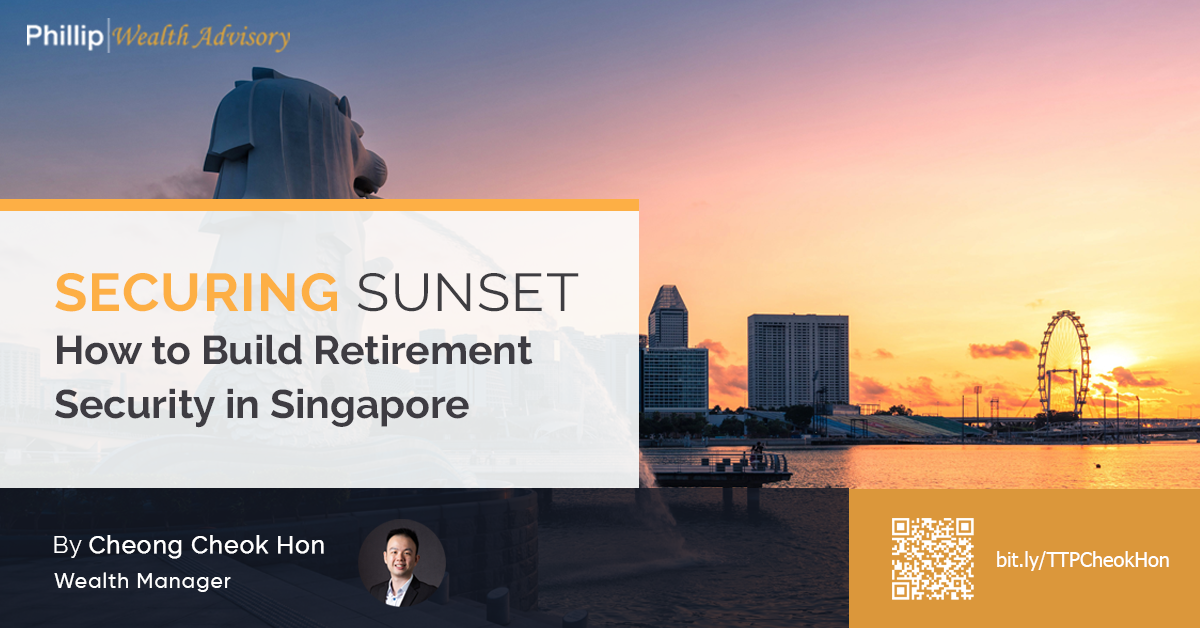Amidst the hustle and bustle of working life, retirement often feels like a distant or abstract event for many. However, it is crucial to plan for retirement while you have the means and ability to do so. So, what are the options and considerations when it comes to retirement planning?
Retirement Planning Considerations
Firstly, we need to consider inflation and its long-term impact on our finances. As explored in my earlier article, “From $50 to $100: Unveiling the Impact of Inflation”, inflation is tied to economic growth and is unlikely to be discouraged in its low and stable form. Related to retirement security, this means that the value of money needed in retirement is likely to differ significantly from its value today, especially for the younger generations. Furthermore, inflation will continue to impact prices as time goes by. Hence, instead of aiming for a ballpark figure like “a million dollars”, which may be difficult to achieve, it is far more effective to use the time and mental space to carefully plan for your unique retirement goals.
Secondly, it is important to recognise that old age and retirement can mean different things depending on the individual. For instance, some retirees may be comfortable about downsizing their lifestyle as they age, while others view retirement as a time for enjoyment after a lifetime’s worth of hard work. Similarly, some may be content to spend within a fixed monthly budget, while others might find such constraints stressful. Additionally, while some retirees aim to build excess funds to pass to their next generation, others may not have this desire. Some might prefer to hold more liquid funds for peace of mind, particularly if they lack health insurance or wish to afford better ward classes if the medical need arises. Others may have family and friends they can count on financially, while others might not.
Financial circumstances, such as income levels and work conditions also play a role. Those with lower incomes or heavier financial responsibilities face challenges in saving for retirement, whereas successful entrepreneurs may not even consider retirement. Self-employed individuals with inconsistent income may have lower propensity to contribute to CPF, while those who are more proficient in growing their surplus savings will approach retirement differently. Hence, it is important to reflect and review your personal circumstances and retirement expectations.
Retirement Instruments and Strategies
When it comes to retirement planning in Singapore, the Central Provident Fund (CPF) is undoubtedly one of the most well-known instruments. Personally, I find CPF to be an invaluable tool for several reasons.
Firstly, CPF contributions offer tax relief, up to a certain cap per year, which effectively increases the first-year return based on one’s tax bracket and offer appealing interest rates. For example, the Special and Retirement Accounts, earn interest pegged to the 12-month average yield of the 10-year Singapore Government Securities (10YSGS) plus 1% (subject to the current floor interest rate of 4% per annum). Historically, these rates have responded to inflation and economic conditions, as evidenced in the 1970s, when rates peaked at 6.50% between 1974 to 1986 [2], even as inflation began to ease from its highs.
Given the interest adjustment mechanism in CPF, one way to assess the scheme is by comparing the amount accumulated in one’s account to the present CPF LIFE Standard Plan payout. For instance, if you have $100,000 in CPF allocated to retirement today, this is projected to provide a monthly payout of approximately $540 – $570 for life from age 65, based on 2024 estimates [3]. This translates, conservatively, into a retirement lifestyle worth around $540 – $570 in today’s terms. While this may cover basic needs, individuals are encouraged to build this amount to meet their preferred lifestyle and account for inflation.
Viewing CPF through this lens could alleviate some of the prevailing anxiety around chasing an ever-increasing retirement goal and provide a reasonable gauge on whether your CPF savings are sufficient. Additionally, a lesser-known benefit is that CPF is protected from creditors under the CPF Act. As such, CPF is not only a reliable foundation for retirement, backed by the Singapore government, but also one with attractive tax benefits and financial security.
Yet, the CPF scheme is not without drawbacks. One of the most common concerns is the lack of access to liquidity in times of need. For more experienced investors, the limited control regarding investment options is another concern.
While there are certainly good reasons for the above, it is thus wise to supplement the CPF scheme with other options.
The Supplementary Retirement Scheme (SRS) has become an increasingly popular tool for retirement planning. Conceivably designed to address some limitations of the CPF scheme, the SRS offers more flexibility, including early withdrawals (with penalties) and self-directed investments, and allows for more tax-deductible contributions to retirement planning each year. However, it is important to note that the scheme sets tax relief and contribution caps at $15,300 annually for Singapore Citizens (SCs) and Permanent Residents (PRs).
For optimisation of the SRS scheme, contributors might target a certain amount, e.g. $400,000, by their prescribed retirement age to optimise tax advantages during withdrawals. This is because only 50% of the withdrawals during the 10-year withdrawal period after the prescribed retirement age is taxable. This can be done using a mix of higher-risk investments with potentially higher returns and lower-risk insurance policies. For example, a single premium of $35,000 at the age of 35 could grow to approximately $100,000 by age 65, based on an estimated yield of 3.56%.
However, contributors should remain mindful of potential policy changes over time, such as adjustments to the floor rate, bonus interest rates, or tax rates, which could impact their plans. This underscores the importance of building multiple layers of financial scaffolding for retirement, as diversification proves its worth in difficult times.
Insurance is another viable instrument for those who can commit long-term, particularly for individuals less disciplined with savings, including me. This is where regular savings policies, often bundled with protection benefits, can provide structure and security.
Upon maturity, these policies offer a lump sum payout, which can be used for various purposes such as creating a liquidity pool, regular monthly/yearly income, or supplement CPF Life payouts to mitigate inflationary pressures in later years. Some insurance income plans also have an additional payout upon the passing of the insured, which can be inherited by the future generations.
For younger people, integrating insurance with a protection element (e.g. coverage for accidents, disability, or critical illnesses) into a responsible retirement plan is crucial. Such coverage can replace potentially lost income should any unforeseen incidents occur during their income-generating years.
Lastly, for those with legacy considerations, investment-linked policies with capital protection upon death can be a viable option to preserve wealth, should an untimely market downturn occur.
For those with higher risk appetite and investment expertise, allocating surplus funds to investments with potential long-term returns of 6-10% can significantly enhance retirement savings. Diversified indices like the STI or S&P 500 have historically delivered these returns, compounding wealth over decades. Over a 30-year period, the compounding effect of these returns could result in an accumulated amount 1.7 to 5.4 times greater than that from a 4% floor rate.
Furthermore, in a higher for longer environment, the traditional strategy of capitalising on the high CPF-SA/RA’s floor rate coupled with low inflation rates to achieve a real return of 2 – 3% is over. To maintain similar real returns, investors may need to reposition this portion of their retirement savings into higher-yielding, quality companies.
However, it is important to acknowledge that investing might not be suitable for everyone, due to market volatility. A recession or untimely macroeconomic event during retirement years could significantly diminish the hard-earned funds accumulated over decades. A prudent approach could be to allocate an investment portfolio in a retirement plan such that only the dividends or excess returns are used to fund costlier discretionary expenditures such as holidays or gifts.
Conclusion
In conclusion, retirement security and strategies are deeply personal and multifaceted. From side hustles and part-time jobs to CPF and diversified investments, the options are vast. This is why engaging with a trusted financial advisor to discuss your personal goals and circumstances can provide tailored guidance to navigate this complex landscape. Wishing you a joyous holiday season and a wonderful start to 2025!
Contributor:

Cheong Cheok Hon
Wealth Manager
Phillip Securities Pte Ltd (A member of PhillipCapital)
http://bit.ly/TTPCheokHon
Reference:
- [1] https://www.mas.gov.sg/-/media/MAS/EPG/MR/2021/Oct/MROct21_SF_A.pdf
- [2] https://www.cpf.gov.sg/service/sfc/servlet.shepherd/version/download/068IW000003qJpdYAE
- [3] https://www.cpf.gov.sg/content/dam/web/member/retirement-income/documents/CPF_LIFE_Payout_Examples.pdf
Disclaimer
These commentaries are intended for general circulation and do not have regard to the specific investment objectives, financial situation and particular needs of any person. Accordingly, no warranty whatsoever is given and no liability whatsoever is accepted for any loss arising whether directly or indirectly as a result of any person acting based on this information. You should seek advice from a financial adviser regarding the suitability of any investment product(s) mentioned herein, taking into account your specific investment objectives, financial situation or particular needs, before making a commitment to invest in such products.
Opinions expressed in these commentaries are subject to change without notice. Investments are subject to investment risks including the possible loss of the principal amount invested. The value of units in any fund and the income from them may fall as well as rise. Past performance figures as well as any projection or forecast used in these commentaries are not necessarily indicative of future or likely performance.
Phillip Securities Pte Ltd (PSPL), its directors, connected persons or employees may from time to time have an interest in the financial instruments mentioned in these commentaries.
The information contained in these commentaries has been obtained from public sources which PSPL has no reason to believe are unreliable and any analysis, forecasts, projections, expectations and opinions (collectively the “Research”) contained in these commentaries are based on such information and are expressions of belief only. PSPL has not verified this information and no representation or warranty, express or implied, is made that such information or Research is accurate, complete or verified or should be relied upon as such. Any such information or Research contained in these commentaries are subject to change, and PSPL shall not have any responsibility to maintain the information or Research made available or to supply any corrections, updates or releases in connection therewith. In no event will PSPL be liable for any special, indirect, incidental or consequential damages which may be incurred from the use of the information or Research made available, even if it has been advised of the possibility of such damages. The companies and their employees mentioned in these commentaries cannot be held liable for any errors, inaccuracies and/or omissions howsoever caused. Any opinion or advice herein is made on a general basis and is subject to change without notice. The information provided in these commentaries may contain optimistic statements regarding future events or future financial performance of countries, markets or companies. You must make your own financial assessment of the relevance, accuracy and adequacy of the information provided in these commentaries.
Views and any strategies described in these commentaries may not be suitable for all investors. Opinions expressed herein may differ from the opinions expressed by other units of PSPL or its connected persons and associates. Any reference to or discussion of investment products or commodities in these commentaries is purely for illustrative purposes only and must not be construed as a recommendation, an offer or solicitation for the subscription, purchase or sale of the investment products or commodities mentioned.
This advertisement has not been reviewed by the Monetary Authority of Singapore.





